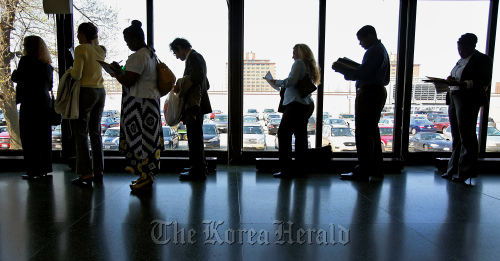Payroll gain in U.S. probably topped 200,000 for fourth consecutive month
Payrolls in the U.S. probably increased by more than 200,000 workers in March for a fourth consecutive month as companies became more optimistic about the outlook for growth, economists said before a report this week.
Employment rose by 205,000 after climbing by 227,000 in February, according to the median projection of 54 economists surveyed by Bloomberg News. The last time hiring advanced at a similar pace and period was in late 1999-early 2000. The jobless rate probably held at a three-year low of 8.3 percent.
The pickup in hiring has boosted consumer confidence to a four-year high, raising the odds that gains in household spending, which accounts for 70 percent of the economy, can be sustained. The improvement in the job market may also help Americans weather the rising cost of gasoline, which Federal Reserve Chairman Ben S. Bernanke said posed a risk to growth.
“The underlying health of the economy is getting better,” said Stephen Stanley, chief economist at Pierpont Securities LLC in Stamford, Connecticut. “We’re getting to a point where some of the hurdles to getting a healthier expansion are starting to be removed.”
 |
Job seekers stand in a line at the 12th Annual Diversity Employment Day Career Fair in Chicago. (Bloomberg) |
The Labor Department report is due April 6. Payroll estimates in the Bloomberg survey ranged from increases of 175,000 to 255,000. Projections for joblessness ranged from 8.1 percent to 8.4 percent.
Another report may show that expansion in the services industry, which makes up almost 90 percent of the economy, held near the fastest pace in a year.
Private payrolls, which exclude government agencies, are forecast to expand by 221,000 after a 233,000 gain in February, according to the survey median. Factory payrolls are projected to rise by 21,000 after increasing by 31,000 in February.
Redwood City, California-based Oracle Corp., the largest maker of database software, is among companies looking to expand their workforce.
“We set a plan in motion to accelerate our hiring,” Mark Hurd, Oracle’s co-president, said on a March 20 earnings call. “This is salespeople and the presales people that support them. We think we have a lot of gas in the tank to drive organic growth given the hiring we’ve done.”
Other measures of the labor market have also shown improvement. Dismissals have waned, suggesting companies may be growing more confident about the economic outlook. Applications for unemployment benefits declined to 359,000 in the week ended March 24, the fewest since April 2008. They averaged 376,750 in January and 366,750 in February, according to Labor Department data.
“A wide range of indicators suggests that the job market has been improving, which is a welcome development indeed,” Bernanke said last week in a speech to the National Association for Business Economics. “Still, conditions remain far from normal, as shown, for example, by the high level of long-term unemployment and the fact that jobs and hours worked remain well below pre-crisis peaks.”
Faster wage gains are needed to help Americans weather gasoline prices that have increased 65 cents this year through March 29, to $3.93 a gallon, according to “AAA,” the nation’s largest auto group.
Wages and salaries in February climbed 0.3 percent after a 0.4 percent advance the previous month, according to the Commerce Department’s revised figures released last week.
Higher stock prices alongside an improving labor market are helping push up consumer confidence. The Standard & Poor’s 500 Index has climbed 12 percent so far this year.
The Bloomberg Consumer Comfort Index climbed to a four-year high in early March and has hovered near there since.
Also this week, the Institute for Supply Management’s gauge of non-manufacturing companies eased in March to 56.9 from 57.3 the prior month, which was the highest since February 2011, according to the median estimate in the Bloomberg survey. Measures greater than 50 signal growth. Figures from the Tempe, Arizona-based group are due on April 4.
(Bloomberg)








